Best Classic Watches [Key Factors To Consider]
Note: This page contains affiliate links.
As an Amazon Associate, I earn from qualifying purchases when you click on the link, but you are not charged extra.
In a world dominated by technology and smart devices, classic watches stand out as timeless pieces that embody craftsmanship, elegance, and history. These watches are more than mere timekeepers; they are symbols of personal style and heritage, appealing to collectors and enthusiasts alike. Whether you’re a seasoned aficionado or a newcomer to the world of horology, understanding the nuances of classic watches is essential for making informed purchasing decisions. This guide will navigate the essential factors to consider when buying classic watches, ensuring that your investment is both meaningful and valuable.
From vintage timepieces that tell stories of the past to contemporary classics that blend modern design with traditional techniques, the landscape of classic watches is diverse and rich. Buyers must familiarize themselves with key aspects such as brand reputation, movement types, and condition assessments to appreciate the true value of a classic watch. By exploring the different categories and styles available, along with tips for ensuring authenticity and quality, this guide aims to equip you with the knowledge necessary to select a classic watch that resonates with your personal style and meets your expectations.
Best Classic Watches: Quick Comparison Table
| Features | Pros | Cons | |
|---|---|---|---|
Luxury Gold-Silver Classic Dress Watch for Men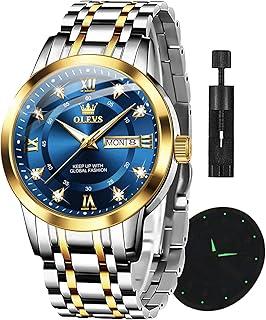 Check Price Check Price |
|
|
|
Luxury Big Face Sport Chronograph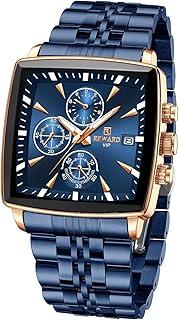 Check Price Check Price |
|
|
|
Business Quartz Big Face Watch Check Price Check Price |
|
|
|
Casual Stainless Steel Day-Date Watch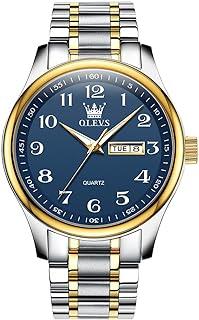 Check Price Check Price |
|
|
|
Premium Rotatable Bezel Analog Watch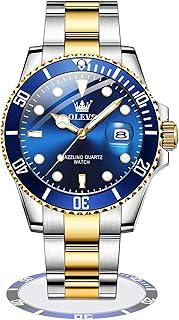 Check Price Check Price |
|
|
|
Luxury Gold Day-Date Dress Watch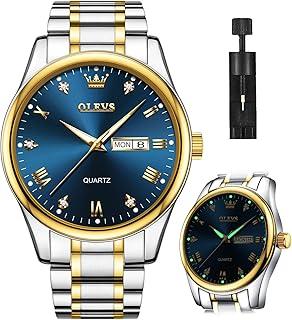 Check Price Check Price |
|
|
|
Two-Tone Diamond Analog Dress Watch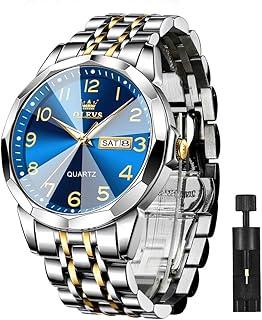 Check Price Check Price |
|
|
|
Classic Two-Tone Big Face Watch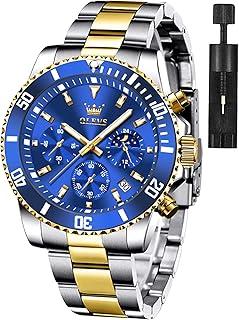 Check Price Check Price |
|
|
|
Women’s Luxury Tungsten Steel Diamond Watch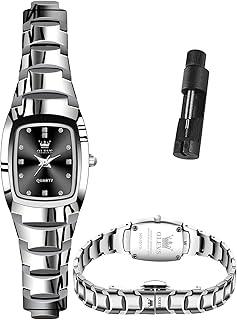 Check Price Check Price |
|
|
|
Vintage Square Large Face Women’s Watch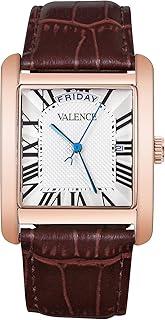 Check Price Check Price |
|
|
|
Recommendations For Best Classic Watches
Luxury Gold-Silver Classic Dress Watch for Men
A sleek and sophisticated men’s watch with a timeless combination of gold and silver tones. The white gold and blue dial make it a standout piece for formal occasions. Its durable stainless steel construction and waterproof capabilities make it a reliable choice for daily wear.
Features:
- Stainless steel construction
- Date function
- Waterproof design
- Classic dress style
- White gold with blue dial
Pros:
- Elegant and versatile design
- Durable stainless steel build
- Water-resistant for daily use
Cons:
- No luminous hands, making it hard to read in the dark
- Basic functionality
Luxury Big Face Sport Chronograph
This luxury men’s watch offers both style and functionality with its big square face, chronograph, and luminous hands. Perfect for both business and casual occasions, it features a stainless steel body, date function, and water resistance, making it suitable for everyday wear.
Features:
- Analog quartz movement
- Big square face design
- Chronograph functionality
- Luminous hands
- Waterproof
- Date function
Pros:
- Sporty yet elegant design
- Chronograph feature adds functionality
- Luminous hands for night readability
- Water-resistant for sports or casual use
Cons:
- Large face might not suit smaller wrists
- Heavier due to its size
Business Quartz Big Face Watch
A classic big-face quartz watch designed for the business professional. With its luminous hands and waterproof features, it balances style and practicality. Available in striking green, black, or blue dials, this watch makes a bold statement in any setting.
Features:
- Quartz movement
- Big face design
- Waterproof
- Luminous hands and markers
- Date function
Pros:
- Easy to read large dial
- Luminous features for low-light conditions
- Water-resistant for everyday wear
Cons:
- Limited additional functions
- May be too large for smaller wrists
Casual Stainless Steel Day-Date Watch
A luxurious yet casual men’s watch featuring a big, easy-to-read face with diamond accents and both Roman and Arabic numerals. Its stainless steel construction, combined with day-date functionality and waterproofing, makes it a perfect accessory for both casual and formal occasions.
Features:
- Analog quartz movement
- Big easy-to-read face
- Day and date function
- Waterproof
- Diamond accents
- Roman and Arabic numerals
Pros:
- Elegant and sophisticated design
- Day and date display
- Diamond accents for a luxurious look
Cons:
- Diamond accents might not suit all tastes
- Heavy design due to materials
Premium Rotatable Bezel Analog Watch
This premium analog watch offers a sophisticated blend of gold and silver stainless steel, coupled with a sporty rotatable bezel. Available in multiple dial colors, it features a date function and is perfect for those seeking a balance between luxury and sportiness.
Features:
- Gold and silver stainless steel design
- Analog movement
- Date function
- Rotatable bezel
- Available in blue, green, and black dials
Pros:
- Premium look with a mix of gold and silver
- Rotatable bezel adds a sporty touch
- Versatile color options
Cons:
- Rotatable bezel may not appeal to everyone
- No luminous features for night visibility
Luxury Gold Day-Date Dress Watch
This men’s dress watch combines luxury and practicality with its gold-tone stainless steel finish, day-date display, and luminous hands. Perfect for business or formal settings, its waterproof design also ensures durability for everyday wear.
Features:
- Analog quartz movement
- Gold-tone stainless steel
- Day and date display
- Luminous hands
- Waterproof
Pros:
- Luxurious gold-tone design
- Luminous hands for night visibility
- Day and date functionality
Cons:
- Gold tone might wear off with time
- Heavy feel due to stainless steel
Two-Tone Diamond Analog Dress Watch
An elegant two-tone men’s dress watch featuring diamond accents and a classic stainless steel design. Its luminous hands and date function ensure both style and functionality, while the waterproof feature adds practicality for daily use.
Features:
- Analog quartz movement
- Two-tone stainless steel
- Diamond accents
- Date function
- Luminous hands
- Waterproof
Pros:
- Elegant two-tone design with diamond accents
- Luminous hands for better readability
- Waterproof for durability
Cons:
- Diamond accents may feel too flashy for some
- Limited additional functions
Classic Two-Tone Big Face Watch
A bold and elegant men’s watch designed with a large, easy-to-read face and luminous hands for night visibility. The two-tone stainless steel design adds a touch of luxury, while the waterproof feature makes it practical for everyday wear.
Features:
- Analog movement
- Big face design
- Date function
- Luminous hands
- Waterproof
- Two-tone stainless steel
Pros:
- Bold and easy-to-read large dial
- Luminous hands for low-light visibility
- Durable two-tone stainless steel construction
Cons:
- Large size may not suit all wrist types
- Limited features beyond date and luminous hands
Women’s Luxury Tungsten Steel Diamond Watch
This luxury women’s watch offers a refined design with a tungsten steel bracelet and elegant diamond accents on a square dial. Its water-resistant feature ensures durability, making it perfect for both work and casual occasions.
Features:
- Tungsten steel bracelet
- Analog quartz movement
- Diamond accents
- Square dial design
- Water-resistant
Pros:
- Durable tungsten steel construction
- Elegant diamond accents
- Compact and lightweight for everyday wear
Cons:
- Small face may be harder to read for some
- Square dial design might not appeal to all
Vintage Square Large Face Women’s Watch
A vintage-inspired women’s watch with a large square face and golden case, perfect for those who appreciate timeless elegance. Featuring a leather band, day and date function, and waterproof design, this watch is both fashionable and practical for daily wear.
Features:
- Quartz movement
- Large square face
- Golden case
- Leather band
- Day and date function
- Waterproof
Pros:
- Stylish vintage design
- Day and date feature adds practicality
- Waterproof for daily use
Cons:
- Large face may not suit all tastes
- Leather band may wear out over time
What To Consider When Choosing Classic Watches
1. Heritage And Brand Reputation
When investing in a classic watch, the brand’s heritage and reputation are paramount. Brands like Rolex, Omega, and Patek Philippe are renowned for their rich histories and pioneering innovations in horology. A watch from a well-established brand often signifies quality, durability, and a legacy of craftsmanship. Research the brand’s background, including its innovations and historical significance in watchmaking. A watch that tells a story not only adds to its charm but can also increase its value over time, making it a wise investment.
2. Craftsmanship And Materials
The craftsmanship behind a watch is a critical factor in its overall quality and appeal. Examine the materials used in the watch’s construction, such as stainless steel, gold, or platinum for the case, and sapphire crystal for the glass. The choice of movement—whether mechanical, automatic, or quartz—also plays a significant role. Mechanical and automatic movements are often preferred in classic watches due to their intricate craftsmanship and the skill involved in their creation. Look for details like the finishing of the movement, the quality of the dial, and the precision of the hands; these factors reveal the level of artistry and care that went into making the watch.
3. Design And Style
Classic watches come in a variety of styles, from elegant dress watches to rugged tool watches. Consider your lifestyle and the occasions for which you plan to wear the watch. A sleek, minimalist design with a simple dial may be ideal for formal events, while a watch with additional features, like a chronograph or a date function, might be more suitable for everyday wear. The choice of color, strap material (leather, metal, or fabric), and size should also complement your personal style and wardrobe. A well-designed watch can seamlessly integrate into your outfit, enhancing your overall aesthetic.
4. Size And Fit
The size and fit of the watch are critical for both comfort and style. Classic watches come in various case diameters and thicknesses, and finding the right fit is essential. Consider the size of your wrist and how the watch will look when worn. A watch that is too large can overpower a smaller wrist, while a watch that is too small may seem lost. Pay attention to the lug width and strap options; you may want to personalize the watch later with a different strap. Ultimately, the watch should feel comfortable and natural on your wrist.
5. Functionality And Features
While classic watches often emphasize aesthetic appeal, functionality should not be overlooked. Consider what features are important to you. For instance, do you require a water resistance rating for swimming or outdoor activities? Would you appreciate a stopwatch function for timing events? Some classic watches also include complications such as moon phases, perpetual calendars, or dual-time zones. Determine which functionalities align with your needs and lifestyle, ensuring that your watch is as practical as it is beautiful.
6. Investment Potential
Classic watches can be valuable investments, but not all timepieces will appreciate in value. If investment potential is a consideration, research the market trends for specific brands and models. Limited editions or watches with historical significance tend to hold or increase their value over time. Additionally, consider the condition of the watch, any accompanying documentation (like original boxes or papers), and the brand’s resale value. A well-chosen classic watch can be a financial asset as well as a personal treasure.
7. Price And Budget
Classic watches span a wide range of price points. Establishing a budget is essential before beginning your search. While some timepieces may command high prices due to their brand prestige or rarity, there are also many affordable options that offer remarkable quality and style. Researching different models and comparing prices can help you find a classic watch that fits within your budget without compromising on quality or aesthetics.
8. Personal Connection
Finally, the most important consideration is your personal connection to the watch. A classic timepiece should resonate with you on an emotional level, representing your values and tastes. Whether it reminds you of a significant life event or simply appeals to your aesthetic sensibilities, the watch should feel special. This personal connection often makes the watch a cherished part of your life, creating memories that enhance its value beyond monetary worth.
Choosing a classic watch is an art that transcends mere functionality; it’s a journey of self-expression, an exploration of heritage, and a connection to craftsmanship that spans generations. As you navigate the considerations outlined above, take the time to reflect on what truly matters to you in a watch. Whether you are drawn to a prestigious brand steeped in history, the intricate workings of a mechanical movement, or a design that complements your personal style, each choice shapes the narrative of your timepiece.
In the end, a classic watch is not just about telling time; it’s about encapsulating moments, celebrating milestones, and expressing individuality. It is an enduring symbol of elegance and sophistication, a piece of art that you wear on your wrist. As you select your ideal watch, remember that it will not only accompany you through the years but will also become a cherished artifact of your personal journey. Embrace the process, trust your instincts, and find a classic watch that speaks to you—one that you will be proud to wear and pass down through generations.
Benefits Of Owning Classic Watches
Owning a classic watch is much more than merely having a means to tell time; it is an investment in artistry, history, and personal style. Classic watches embody a legacy of craftsmanship and elegance that transcends trends and time. Here are several compelling benefits to consider when contemplating the acquisition of a classic timepiece:
1. Timeless Aesthetic Appeal
One of the most striking benefits of classic watches is their enduring aesthetic. Classic designs often feature clean lines, intricate detailing, and harmonious proportions that stand the test of time. Unlike modern watches, which may trend toward flashy or overly complicated designs, classic timepieces exude understated elegance. Whether it’s the slender profile of a vintage dress watch or the rugged charm of a classic diver’s watch, these pieces can seamlessly enhance a wide array of outfits, from formal attire to casual wear. The timeless appeal ensures that these watches are not just relevant today but will continue to be appreciated in the years to come.
2. Heritage And Storytelling
Each classic watch has its own unique story, often steeped in history and tradition. Many renowned watchmakers have been crafting their masterpieces for centuries, and owning a classic watch allows you to become a part of that rich narrative. For instance, brands like Rolex, Patek Philippe, and Omega have contributed significantly to horological advancements, each with milestones and achievements that mark their legacy. Collectors often find joy in researching and learning about the origins, notable owners, and historical significance of their timepieces. Wearing a classic watch can spark conversations, providing an opportunity to share the story behind the piece and connect with fellow enthusiasts.
3. Investment Potential
While not all classic watches appreciate significantly over time, many do hold or increase their value, making them a worthwhile investment. Certain models, especially limited editions or those from prestigious brands, can appreciate dramatically due to demand in the collector’s market. For example, vintage watches from brands like Patek Philippe or Audemars Piguet often sell for several times their original prices at auctions. This potential for appreciation, combined with the watch’s intrinsic value as a piece of craftsmanship, makes classic watches appealing not just for their aesthetic but also as financial assets.
4. Craftsmanship And Quality
Classic watches are synonymous with exceptional craftsmanship. The intricate mechanics, often visible through transparent case backs, showcase the skill of master watchmakers who have honed their craft over decades. These watches are often assembled by hand, with each component meticulously crafted and tested for precision and durability. The attention to detail extends to the materials used, with many classic watches made from high-quality metals, sapphire crystal, and leather. This level of craftsmanship ensures that classic watches are not just functional but are also robust and reliable, often outlasting modern alternatives that rely on mass production techniques.
5. Personal Identity And Style
Wearing a classic watch is a powerful form of self-expression. A watch can reflect your personal style, values, and even your aspirations. For some, a classic watch signifies a commitment to tradition, quality, and excellence. For others, it may represent a passion for horology or an appreciation for design. With numerous styles available—from the understated elegance of a minimalist dress watch to the rugged functionality of a classic pilot’s watch—there’s a classic timepiece to match any personality. As you wear your watch, it becomes an integral part of your identity, telling your story to the world.
6. Sustainability
In an age where fast fashion and disposable products dominate, classic watches stand out as symbols of sustainability. Many classic timepieces are designed to last for generations, encouraging a culture of longevity over disposability. By investing in a quality watch, you contribute to a more sustainable approach to consumption, prioritizing quality over quantity. Additionally, classic watches can often be repaired and restored, allowing them to remain functional and beautiful long after their initial purchase. This durability and repairability align with a growing movement toward sustainable luxury.
The benefits of owning a classic watch extend far beyond mere timekeeping. These exquisite timepieces represent a fusion of artistry, history, and craftsmanship that offers both emotional and financial rewards. From their timeless aesthetic appeal and rich heritage to their potential as investments, classic watches invite you to become part of a greater narrative—a narrative steeped in tradition and a commitment to quality.
Moreover, they serve as a powerful form of personal expression, enabling wearers to communicate their style and values. In a world that increasingly leans towards disposable consumerism, classic watches stand as a testament to sustainability, encouraging mindful consumption and a celebration of craftsmanship.
Ultimately, investing in a classic watch is not merely about acquiring a luxurious accessory; it is about embracing a piece of history, a testament to human ingenuity, and a story that unfolds with each passing second. Whether worn as a daily companion or cherished as part of a collection, a classic watch promises to be a timeless companion, transcending generations while continuing to inspire admiration and respect.
Features To Look For In The Best Classic Watches
When it comes to selecting a classic watch, the journey is as significant as the destination. A classic timepiece is not just about telling time; it’s a statement of style, craftsmanship, and often, a reflection of personal heritage. Here, we delve into the quintessential features that distinguish the best classic watches, ensuring that your choice is both an investment and a cherished possession.
1. Timeless Design
The hallmark of a classic watch lies in its timeless design. Aesthetics play a pivotal role; the watch should evoke a sense of elegance and sophistication that transcends fleeting fashion trends. Look for clean lines, balanced proportions, and minimalistic dials that enhance readability without unnecessary embellishments. Traditional designs often incorporate elements such as Roman numerals, vintage-inspired hands, and high-quality materials that contribute to their enduring appeal.
-
Case Material: The case material is crucial in defining a watch’s character. Stainless steel remains a popular choice for its durability and versatility, while precious metals like gold or platinum convey luxury and status. Vintage pieces may also feature materials such as brass or even rare metals, each offering a unique patina that tells its own story over time.
-
Dial Style: The watch face, or dial, is where form meets function. Classic watches often sport simple, uncluttered dials with a distinct focus on legibility. Subtle textures, such as sunburst or matte finishes, can enhance visual interest without overwhelming the design. Consider whether you prefer a white or cream dial, as these tones often complement a range of styles and outfits.
2. Quality Movement
At the heart of every great watch is its movement, or mechanism, which can greatly influence both performance and value. There are two primary types of movements: mechanical and quartz.
-
Mechanical Movements: Mechanical watches, either manual or automatic, are revered for their craftsmanship and artistry. Manual movements require regular winding, while automatic movements wind themselves as the wearer moves. The intricate inner workings of mechanical watches, often visible through transparent case backs, are a testament to the watchmaker’s skill. These timepieces are ideal for collectors and enthusiasts who appreciate the engineering behind horology.
-
Quartz Movements: Quartz watches utilize battery-powered movements, providing unparalleled accuracy and minimal maintenance. While they may lack the romantic appeal of mechanical movements, many high-end quartz models boast exceptional craftsmanship and design, making them suitable for those who prioritize reliability.
3. Heritage And Brand Reputation
A classic watch is often intertwined with the legacy of the brand that produces it. Renowned watchmakers like Patek Philippe, Omega, and Rolex have built their reputations on decades, if not centuries, of expertise, innovation, and quality. Researching a brand’s history can provide insights into its values and commitment to craftsmanship. Additionally, brands with strong legacies often maintain higher resale values, making them a prudent choice for collectors.
- Limited Editions: Watches released in limited quantities or with special features tend to appreciate in value over time, adding a layer of exclusivity. Limited editions often celebrate milestones or significant events in the brand’s history, making them particularly desirable among collectors.
4. Craftsmanship And Detailing
Attention to detail is the soul of any classic watch. Examine the finishing touches, such as the quality of the case polish, the intricacy of the engravings, and the smoothness of the movement. High-quality watches often feature hand-finished components and meticulous assembly, which can elevate the overall aesthetic and tactile experience.
-
Sapphire Crystal: The watch glass, typically made of sapphire crystal, should be scratch-resistant and durable, ensuring the dial remains clear and pristine. A quality watch will often have anti-reflective coatings to enhance visibility in various lighting conditions.
-
Bracelet and Strap: The choice of strap or bracelet can dramatically affect the overall impression of a watch. Leather straps evoke a sense of tradition and warmth, while metal bracelets offer a contemporary edge and durability. Look for quality materials and secure fastenings that enhance comfort and longevity.
5. Versatility
The best classic watches should seamlessly transition between various settings, from formal occasions to casual outings. A versatile watch is one that complements both a tailored suit and a casual outfit, allowing for daily wear without compromising style. Neutral tones and classic designs are key to ensuring your timepiece remains relevant across various environments.
6. Size And Fit
The size and fit of the watch are critical to its overall aesthetic and comfort. Classic watches typically range from 36mm to 40mm in diameter for men and 28mm to 36mm for women, although personal preference plays a significant role. Consider your wrist size and how the watch’s proportions will appear against it. A well-fitted watch enhances the wearer’s confidence and ensures a more enjoyable wearing experience.
Choosing the best classic watch is a journey that encompasses much more than mere functionality. It’s about investing in a piece of artistry that resonates with your identity, celebrating time in a manner that reflects both your personal style and values. From timeless design and impeccable craftsmanship to the intricate workings of quality movements and the prestige of heritage brands, each feature plays an integral role in shaping a classic watch’s character.
When selecting your classic timepiece, take the time to appreciate the craftsmanship, history, and versatility that each watch offers. Remember, a classic watch is not just a tool for telling time; it is a legacy, a companion for life’s moments, and an expression of elegance that transcends generations. By considering these features, you can ensure that your investment in a classic watch will not only serve you well in the present but also carry a timeless charm for years to come.
How To Choose The Right Size
Choosing the right size for a classic watch is an art as much as it is a science. The watch you wear not only serves the practical purpose of telling time but also acts as a statement piece that reflects your personal style and taste. The right size ensures comfort and enhances the aesthetic appeal, allowing the watch to become a seamless extension of your attire. Here’s a deep dive into the factors that influence your choice of watch size, ensuring you find the perfect fit for your wrist and style.
1. Understanding Watch Size Measurements
When discussing watch sizes, we primarily refer to two key measurements: case diameter and case thickness. The case diameter is measured from one side of the case to the other, typically expressed in millimeters (mm). Common case diameters range from 34 mm to 50 mm, with men’s watches usually sitting between 38 mm and 46 mm, and women’s watches often ranging from 28 mm to 36 mm.
Case thickness, on the other hand, affects the watch’s overall bulkiness. A thicker case often implies a more robust, substantial feel, while a thinner case can offer a sleeker, more elegant profile. While these measurements are essential, they should not be looked at in isolation; rather, they should be considered alongside other elements that contribute to the watch’s overall fit and feel.
2. Wrist Size Considerations
Before diving into specific measurements, it’s crucial to understand your wrist size. The right watch should sit comfortably on your wrist without being overly loose or tight. To determine your wrist size, wrap a soft measuring tape around your wrist just above the bone, noting the measurement in millimeters.
-
Small Wrists (up to 6.5 inches or 165 mm): For those with smaller wrists, watches with a case diameter of 34 mm to 40 mm are often ideal. These sizes ensure the watch doesn’t overwhelm the wrist and maintains a balanced look.
-
Medium Wrists (6.5 to 7.5 inches or 165 mm to 190 mm): A diameter of 38 mm to 42 mm is generally suitable for medium-sized wrists, offering versatility and a range of styles.
-
Large Wrists (over 7.5 inches or 190 mm): Individuals with larger wrists can comfortably wear watches with a case diameter of 40 mm and above. A size of 42 mm to 46 mm allows for a bold statement while maintaining comfort.
3. Watch Style And Functionality
The style of the watch significantly impacts the perceived size. For instance, a vintage dress watch typically has a more modest size than a sporty diver’s watch, which tends to be larger and bulkier. Consider the following styles:
-
Dress Watches: These are generally sleek, minimalist designs meant for formal occasions. A classic dress watch often measures between 34 mm to 40 mm in diameter. A thinner case is preferable for a refined appearance.
-
Diver’s Watches: Known for their durability and water resistance, diver’s watches usually have a more substantial build, typically ranging from 40 mm to 44 mm. The larger size aids in legibility underwater and adds a rugged aesthetic.
-
Chronographs: With additional functions such as timers, chronograph watches often come with larger cases to accommodate multiple sub-dials and complications. They usually range from 40 mm to 50 mm.
4. Personal Style And Preferences
Ultimately, your personal style should guide your choice of watch size. Consider how the watch complements your wardrobe and lifestyle. If you often wear tailored suits, a classic dress watch with a smaller case may enhance your look. Conversely, if your style leans toward casual or sporty, a larger, bolder watch could make a more significant impact.
5. Try Before You Buy
The best way to determine the right size is to try on different styles and sizes. Visit a store or a boutique to experience how various watches feel on your wrist. Pay attention to how the watch sits against your skin, whether it feels secure without being too tight, and how it complements your hand movements.
6. Conclusion: Striking The Balance
Choosing the right size watch requires balancing functionality, aesthetics, and personal preference. By understanding the nuances of watch measurements, wrist sizes, styles, and your unique tastes, you can find a classic watch that fits perfectly—both in size and style.
Selecting a classic watch that fits well and complements your style is a nuanced process, blending art and practicality. The journey begins with an understanding of essential size metrics—case diameter and thickness—while recognizing that these figures must harmonize with your wrist size and personal aesthetic. The right watch becomes more than a time-telling device; it transforms into an extension of your identity, a reflection of your taste and lifestyle. As you explore various styles—be it a sophisticated dress watch, a robust diver's timepiece, or a multifunctional chronograph—consider how each watch interacts with your wardrobe and occasions. The excitement of trying different watches enhances your experience, allowing you to discover what resonates most with your style. Ultimately, the right classic watch is one that not only fits comfortably but also elevates your confidence and expression. In a world of fast fashion, a timeless watch stands out as a symbol of taste, longevity, and individuality. Embrace the journey of selection, and you will find a classic timepiece that serves as both a practical tool and a cherished accessory for years to come.
Durability And Performance
When one thinks of classic watches, a multitude of iconic timepieces come to mind—each with its unique story, craftsmanship, and legacy. Yet, beyond their aesthetic appeal and historical significance, classic watches are revered for their durability and performance. These qualities are what have enabled them to transcend generations, remaining relevant and desirable in an ever-evolving world of fashion and technology.
Durability: Built To Last
At the heart of a classic watch’s allure is its remarkable durability. Constructed from premium materials, such as stainless steel, gold, and even ceramic, these timepieces are designed to withstand the test of time. Take, for example, the Rolex Submariner, renowned not only for its elegant design but also for its robust build. This watch features a water-resistant case that can endure depths of up to 300 meters, making it a favorite among divers and adventure seekers alike. The scratch-resistant sapphire crystal adds another layer of protection, ensuring that the watch face remains pristine, even in the most challenging conditions.
Moreover, classic watches often utilize mechanical movements, either manual or automatic, which are celebrated for their reliability and longevity. Unlike quartz watches, which can require battery replacements and may have a shorter lifespan, mechanical watches can last for decades, if not centuries, with proper maintenance. The intricate engineering behind these movements speaks to a tradition of horological expertise that prioritizes craftsmanship over mass production. Brands like Patek Philippe and Audemars Piguet have built their reputations on creating watches that are not only exquisite in design but also meticulously engineered for performance and longevity.
Performance: Precision And Functionality
The performance of classic watches is as impressive as their durability. Many iconic models are not just timekeepers but also serve various functions, from chronographs to perpetual calendars. The chronograph function, found in models such as the Omega Speedmaster, allows the wearer to measure elapsed time with remarkable precision. This feature was famously utilized by NASA during the Apollo missions, underscoring the watch’s reliability under extreme conditions.
Furthermore, the accuracy of mechanical movements has improved significantly over the years. Many luxury brands employ rigorous testing methods to ensure that their watches adhere to high standards of precision. The Swiss Official Chronometer Testing Institute (COSC) certifies chronometers that meet strict accuracy criteria, ensuring that the timepiece can withstand the rigors of daily use while maintaining excellent timekeeping performance.
Beyond accuracy, many classic watches also embrace innovative features while remaining true to their heritage. For instance, the IWC Big Pilot’s Watch combines modern aviation technology with classic aesthetics, featuring a power reserve indicator and a large, easy-to-read dial. This melding of form and function exemplifies how classic watches can cater to contemporary needs while maintaining a timeless appeal.
Craftsmanship And Heritage
It is essential to note that the durability and performance of classic watches are not solely attributed to their materials and mechanics but also to the craftsmanship that goes into each piece. Many of these watches are hand-assembled by skilled artisans, each contributing to the meticulous attention to detail. From the finishing of the movement to the polishing of the case, every aspect of production is carefully considered, resulting in a timepiece that embodies both artistry and functionality.
The heritage of these brands plays a significant role in their quality assurance. Many manufacturers have been producing watches for over a century, allowing them to refine their techniques and uphold traditions passed down through generations. This lineage of expertise ensures that classic watches are not just products but are imbued with a sense of history and culture, making them cherished heirlooms for future generations.
In a world increasingly dominated by digital technology and fast fashion, classic watches stand as a testament to enduring quality and timeless design. Their durability and performance go beyond mere functionality; they represent a marriage of craftsmanship, heritage, and innovation. Each classic watch tells a story, embodying the spirit of its era while remaining relevant in contemporary society.
The intricate craftsmanship behind each piece ensures that these watches are built to last, serving not just as tools for timekeeping but as symbols of art and engineering excellence. Whether it’s a vintage Omega or a modern-day Patek Philippe, classic watches resonate with enthusiasts and collectors, inviting them to appreciate the meticulous detail that goes into each creation.
As we continue to navigate an ever-changing landscape of fashion and technology, the classic watch remains a steadfast companion—one that honors tradition while adapting to the needs of today’s discerning consumers. Investing in a classic timepiece is not merely a purchase; it is a commitment to owning a piece of history that embodies the values of durability and performance, forever etched in the annals of horological excellence.
How To Care For Your Classic Watches
Caring for classic watches is an art that combines knowledge, dedication, and a deep appreciation for craftsmanship. Whether you own a vintage timepiece from a renowned brand or an heirloom passed down through generations, proper care is crucial to ensure its longevity and functionality. Here are some essential steps to keep your classic watches in pristine condition.
1. Regular Cleaning
Keeping your classic watch clean is paramount to preserving its beauty and functionality. Dust, dirt, and grime can accumulate on the watch case and strap, detracting from its appearance and potentially interfering with its mechanics.
-
Cleaning the Case: Use a soft, lint-free cloth to gently wipe the watch case. For stainless steel cases, you can use a mild soap solution with water. Avoid harsh chemicals or abrasive materials that can scratch the surface.
-
Cleaning the Crystal: The watch crystal, whether made of mineral glass or sapphire, should be cleaned using a specialized cleaner or a solution of mild soap and water. Gently polish it with a soft cloth to prevent scratches.
-
Cleaning the Strap: Leather straps require special care. Use a leather cleaner specifically designed for watch bands, applying it with a soft cloth to avoid damaging the material. For metal bracelets, soak the band in lukewarm water with mild soap, then scrub gently with a soft brush to remove any dirt trapped between the links.
2. Winding And Movement Maintenance
Classic mechanical watches need to be wound regularly to keep them functioning accurately. If you own a manual-wind watch, it’s important to establish a routine for winding it.
-
Winding Manual Watches: Wind the watch daily, turning the crown gently until you feel resistance. Avoid over-winding, as this can damage the movement. For automatic watches, wearing the watch regularly will wind the mainspring automatically. If not worn for an extended period, consider using a watch winder to keep the movement active.
-
Regular Service Intervals: Mechanical watches should be serviced every 3 to 5 years by a qualified watchmaker. This service typically includes cleaning the movement, lubricating parts, and checking the accuracy. Addressing minor issues early can prevent more significant damage down the line.
3. Storage And Environment
How you store your classic watch when it’s not being worn can greatly affect its longevity. Proper storage protects the watch from environmental hazards like dust, moisture, and temperature fluctuations.
-
Watch Box: Store your watch in a dedicated watch box or case that offers cushioning and protection from dust. Look for a case with individual compartments to prevent scratches from contact with other watches.
-
Climate Control: Keep your watch in a climate-controlled environment. Extreme heat, humidity, or cold can cause expansion and contraction of materials, which may lead to misalignment or damage. Avoid storing your watch in places like attics or basements, where temperature and humidity levels fluctuate.
4. Water Resistance Awareness
While many classic watches boast water resistance, it’s vital to know their limits. Vintage models may not retain their original water resistance due to aging seals and gaskets.
-
Check Water Resistance: If your classic watch has a water-resistant rating, ensure the crown is fully pushed in or screwed down before exposure to water. Regularly test the water resistance, especially if the watch has been exposed to moisture, by having it checked by a professional.
-
Avoid Water Exposure: If you’re unsure about the water resistance of your watch, it’s best to avoid exposure to water altogether. Remove your watch before swimming, showering, or washing hands to prevent potential water damage.
5. Avoiding Magnetic Fields
Classic watches can be susceptible to magnetic fields, which can disrupt their delicate movements.
- Limit Exposure: Keep your watch away from electronic devices such as smartphones, speakers, and other gadgets that emit strong magnetic fields. If you suspect your watch has been magnetized, a qualified watchmaker can demagnetize it for you.
6. Mindfulness With Jewelry
When wearing a classic watch, be mindful of how it interacts with other jewelry.
- Avoid Clashes: Wearing your watch alongside other bracelets or bangles can lead to scratches and damage. To preserve the integrity of both your watch and your other pieces, consider removing rings and bracelets before donning your classic timepiece.
Caring for your classic watch is an essential practice that combines a deep respect for horological craftsmanship with the practical knowledge of maintenance. By adhering to the cleaning and maintenance protocols outlined above, you not only preserve the watch’s functionality and appearance but also its history and sentimental value.
As you navigate the world of classic timepieces, remember that each watch carries a story, often reflecting its owner’s journey through life. By committing to thoughtful care, you ensure that your watch will continue to tell its story for generations to come. Embrace the responsibility of watch ownership, and you’ll find that the rewards—timeless beauty, functionality, and nostalgia—are well worth the effort. Whether it’s a family heirloom or a recent acquisition, nurturing your classic watch is a labor of love, making each tick of the second hand a reminder of the beauty and precision encapsulated in every moment.
Comparing Classic Watches With Alternatives
In the world of horology, the classic watch holds a revered position, synonymous with timeless elegance, precision engineering, and a rich history that encapsulates the evolution of human craftsmanship. However, as technology advances and lifestyles evolve, alternatives to classic watches have emerged, offering a range of features and aesthetics that appeal to a diverse audience. This comparison delves deep into the fundamental differences between classic watches and their modern alternatives, including smartwatches, hybrid timepieces, and fashion watches.
The Allure Of Classic Watches
Classic watches, such as mechanical timepieces from brands like Rolex, Omega, and Patek Philippe, are celebrated for their artistry and tradition. Each piece tells a story, often reflecting decades or even centuries of heritage. These watches are typically crafted from high-quality materials, including stainless steel, gold, and precious gems, and feature intricate movements that showcase the mastery of skilled watchmakers. The mechanical movement, whether automatic or manual, is a testament to engineering prowess, allowing the watch to operate without batteries and adding a layer of complexity and charm.
The appeal of classic watches extends beyond their technical aspects. They are often seen as status symbols, with certain models becoming synonymous with luxury and sophistication. For instance, the iconic Rolex Submariner or the elegant Patek Philippe Calatrava is not just timekeepers but also pieces of art that can be passed down through generations. These watches often appreciate in value, making them not just an accessory but also an investment.
The Rise Of Smartwatches
In stark contrast, smartwatches have burst onto the scene in recent years, offering functionality that far surpasses traditional timekeeping. Brands like Apple, Samsung, and Garmin have revolutionized how we perceive wristwatches by integrating advanced technology that caters to modern lifestyle demands. Smartwatches are equipped with features like fitness tracking, notifications, GPS, and even health monitoring functions such as heart rate and blood oxygen level tracking.
One of the primary advantages of smartwatches is their versatility. They can be customized with various watch faces and bands, allowing users to change their style on a whim. Furthermore, the convenience of receiving messages, calls, and app notifications directly on the wrist has become increasingly appealing in our fast-paced lives. However, despite their modern benefits, many traditionalists argue that smartwatches lack the emotional and aesthetic depth of classic timepieces, viewing them as mere gadgets rather than expressions of personal style.
Hybrid Timepieces: The Best Of Both Worlds
The emergence of hybrid watches represents a fascinating middle ground between classic aesthetics and modern technology. These timepieces combine traditional analog displays with smart features, such as activity tracking and smartphone connectivity. Brands like Garmin and Fossil have successfully created watches that maintain the timeless elegance of classic designs while incorporating useful functionalities like notifications and fitness tracking.
Hybrid watches often appeal to those who appreciate the craftsmanship of traditional timepieces but want the convenience that technology offers. They often feature classic designs, with leather straps and stainless steel cases, but boast added capabilities like Bluetooth connectivity and smartphone synchronization. This blend allows users to enjoy the aesthetics of a classic watch while still engaging with the modern digital world, making them a popular choice for those who value both form and function.
Fashion Watches: A Style Statement
On the other end of the spectrum, fashion watches have gained popularity, particularly among younger demographics looking for affordable, trendy options. Brands like Michael Kors, Fossil, and Daniel Wellington offer stylish designs that prioritize aesthetics over intricate mechanics. These watches are often made with less expensive materials, such as quartz movements and synthetic bands, making them accessible to a broader audience.
While fashion watches may not have the same level of prestige or craftsmanship associated with classic timepieces, they serve a distinct purpose: self-expression. They cater to the desire for personalization, with various styles, colors, and designs that resonate with individual tastes. This category of watches is less about horological heritage and more about making a bold fashion statement, allowing wearers to change their look frequently without a significant financial commitment.
The watch industry today is a rich tapestry woven with tradition and innovation, where classic watches and modern alternatives each have their unique place. Classic timepieces represent a timeless elegance and craftsmanship that transcends trends, appealing to those who value heritage, artistry, and the mechanical marvels of horology. Their allure lies in their history, quality, and the status they confer upon the wearer, making them prized possessions and valuable investments. In contrast, alternatives like smartwatches and hybrid timepieces have reshaped our understanding of wristwatches, merging technology with style to meet the demands of contemporary life. Smartwatches cater to a tech-savvy audience seeking functionality and convenience, while hybrid models bridge the gap, offering both style and modern features. Fashion watches, on the other hand, focus on trendiness and affordability, appealing to a younger demographic eager to express their personal style. Ultimately, the choice between classic watches and their alternatives boils down to personal preference and lifestyle needs. Each category has its strengths, catering to different segments of the market. While classic watches hold an irreplaceable charm and legacy, modern alternatives have opened the door to a new generation of watch enthusiasts, blending the best of both worlds. In this dynamic landscape, there is no definitive answer as to which is superior; rather, the watch you choose reflects your personal style, values, and how you wish to engage with the world around you. Whether it’s the timeless sophistication of a classic watch or the modern convenience of a smartwatch, each type serves a purpose, making the wristwatch a continually evolving symbol of human ingenuity and expression.
Style And Design Trends For Classic Watches
Classic watches are a timeless symbol of sophistication, blending artistry, tradition, and precision. In recent years, the world of horology has seen a renaissance in classic watch styles, as brands seek to revive and reinterpret designs that have stood the test of time. Let’s delve into the current style and design trends shaping classic watches today, examining the elements that evoke nostalgia while embracing modernity.
Vintage Revival
One of the most striking trends in classic watch design is the revival of vintage aesthetics. Watchmakers are increasingly drawing inspiration from their archives, resurrecting iconic models that first graced wrists decades ago. This resurgence is often characterized by the use of vintage-inspired materials, such as warm-toned metals and aged leather straps, which evoke a sense of history and craftsmanship.
Brands like Omega and TAG Heuer have released limited-edition models that pay homage to their storied pasts. The Omega Speedmaster, for instance, has seen various reinterpretations that reflect its iconic status as the first watch on the moon. These modern iterations often incorporate subtle design tweaks that enhance functionality while staying true to the original spirit, creating a harmonious balance between nostalgia and innovation.
Minimalism And Simplicity
In stark contrast to the elaborate designs of the past, many classic watches today are embracing minimalism. This trend leans heavily on simplicity, favoring clean lines and uncluttered dials. The “less is more” philosophy is particularly evident in dress watches, where brands like Nomos Glashütte and Seiko are championing understated elegance.
These minimalist designs often feature streamlined hour markers and understated color palettes, allowing the wearer to appreciate the watch’s craftsmanship without distraction. The focus is on the quality of materials and the precision of the movement, rather than ornate embellishments. This trend resonates with modern consumers who appreciate functional design that complements their lifestyle.
Eco-Friendly Materials
Sustainability has become a significant consideration in the fashion industry, and the watch sector is no exception. Classic watch brands are increasingly using eco-friendly materials in their designs, appealing to environmentally conscious consumers. This trend is manifested through the use of recycled metals, ethically sourced gemstones, and innovative materials such as sustainable leather alternatives.
Brands like Panerai are leading the charge by introducing watches made from eco-friendly materials without compromising on luxury. Their commitment to sustainability reflects a broader movement within the industry, emphasizing that classic elegance can coexist with responsible practices. This not only enhances the appeal of classic watches but also ensures their relevance in an evolving market.
Technological Integration
While classic watches are often lauded for their mechanical movements, the integration of technology into traditional designs has become a notable trend. Smartwatches have ushered in a new era, prompting classic watchmakers to innovate while retaining their heritage. Hybrid models that blend analog and digital features are gaining traction, appealing to consumers who seek both timeless design and modern functionality.
For example, brands like Frederique Constant have introduced smartwatches that maintain the elegance of traditional timepieces while incorporating health monitoring and connectivity features. This fusion of classic aesthetics with modern technology allows watchmakers to cater to a broader audience, ensuring that classic watches remain relevant in an increasingly digital world.
Bold Colors And Unique Textures
While classic watches often gravitate towards subdued palettes, there has been a noticeable shift towards bold colors and unique textures. This trend allows brands to express creativity and individuality, attracting a younger demographic eager for self-expression. Brands like Swatch have embraced this trend with vibrant designs and playful materials, encouraging wearers to experiment with their style.
Unique textures, such as distressed leather, matte finishes, and ceramic cases, add an extra layer of depth to classic watch designs. These elements not only enhance visual appeal but also offer tactile experiences that resonate with discerning consumers. The combination of traditional forms with modern colors and textures creates a fresh perspective on classic timepieces.
Emphasis On Heritage And Craftsmanship
As the demand for authenticity continues to rise, watchmakers are increasingly emphasizing their heritage and craftsmanship. Classic watches are not merely instruments for telling time; they are artifacts steeped in history and tradition. Brands are keen to highlight their artisanal processes, showcasing the meticulous craftsmanship that goes into each timepiece.
This focus on heritage often manifests in storytelling, where brands share the narrative behind a watch’s design, its inspirations, and the artisans who bring it to life. By fostering a deeper connection with consumers, watchmakers can elevate the status of their products, transforming them into cherished heirlooms rather than mere accessories.
Conclusion
The world of classic watches is undergoing a vibrant transformation, blending traditional artistry with contemporary design trends. As vintage aesthetics resurge and minimalism takes center stage, watchmakers are finding innovative ways to captivate modern audiences while honoring their legacies. The use of eco-friendly materials and the integration of technology into classic designs reflect a conscious shift towards sustainability and functionality, ensuring that these timepieces remain relevant in an ever-evolving marketplace.
Moreover, the growing emphasis on unique colors, textures, and craftsmanship signifies a broader movement towards individuality and authenticity. In this dynamic landscape, classic watches continue to symbolize timeless elegance, transcending mere fashion trends to become treasured pieces of art that resonate with both history and modernity.
As we look to the future, the enduring appeal of classic watches lies in their ability to adapt while remaining steadfast in their heritage. Whether through revived vintage designs, sustainable practices, or innovative integrations, classic watches will continue to enchant enthusiasts and newcomers alike, ensuring that their legacy is preserved for generations to come.
FAQs
What Defines A Classic Watch?
A classic watch is typically characterized by its timeless design, craftsmanship, and enduring appeal. These watches often feature traditional styles, high-quality materials, and reliable movements, making them suitable for both formal and casual occasions.
How Do I Choose The Right Classic Watch For My Style?
Choosing the right classic watch involves considering your personal style, the occasions you’ll wear it for, and the type of movement you prefer (mechanical vs. quartz). Look for designs that complement your wardrobe, whether it be a dress watch for formal events or a more casual piece for everyday wear.
What Are Some Popular Brands Known For Classic Watches?
Several brands are renowned for their classic watches, including Rolex, Omega, Patek Philippe, Jaeger-LeCoultre, and Longines. Each brand has its unique heritage and signature styles that reflect a commitment to quality and tradition.
Are Classic Watches A Good Investment?
Classic watches can be a good investment, as some models appreciate in value over time due to their rarity and demand. Brands with a storied history and limited production runs are often more sought after. However, it’s important to do thorough research and consult with experts before making an investment.
What Maintenance Do Classic Watches Require?
Classic watches require regular maintenance to ensure longevity and performance. This typically includes periodic servicing every 3-5 years, which involves cleaning, oiling, and checking the movement. Keeping the watch away from extreme temperatures and magnetic fields can also help maintain its accuracy.
How Can I Tell If A Classic Watch Is Authentic?
To verify the authenticity of a classic watch, examine its serial and model numbers, which can often be found on the case or the movement. Research the brand’s specific markings and features, and consider consulting an expert or obtaining a certification from a reputable dealer.
What Are The Differences Between Quartz And Mechanical Movements In Classic Watches?
Quartz movements use battery power and are known for their accuracy and low maintenance, while mechanical movements, which can be either manual or automatic, rely on intricate gears and require regular winding or movement to function. Mechanical watches are often favored for their craftsmanship and heritage.
Can Classic Watches Be Worn In Water?
Many classic watches have varying degrees of water resistance, but it’s crucial to check the manufacturer’s specifications. Water-resistant models can generally withstand splashes or brief immersion, while others may not be suitable for any exposure to water. Always ensure the crown is fully pushed in or screwed down before exposure to moisture.
What Should I Consider When Buying A Vintage Classic Watch?
When purchasing a vintage classic watch, consider its condition, provenance, and authenticity. Look for signs of wear, the originality of parts, and any accompanying documentation, such as the original box and papers. Understanding market trends and the watch’s historical significance can also aid in making an informed purchase.
How Do I Care For And Store My Classic Watch?
To care for and store your classic watch, clean it regularly with a soft, lint-free cloth, and store it in a cool, dry place away from direct sunlight. Use a watch box or case to protect it from dust and potential damage. If your watch is mechanical, consider using a watch winder to maintain its movement when not in use.
